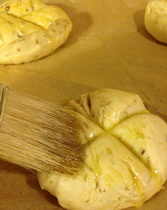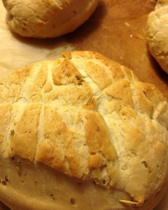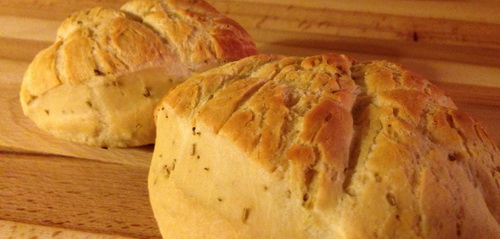I grew up baking bread in a bread maker. The only thing I knew about kneading was that it was the loudest stage in the machine’s process. Favorite memories from this household activity include catching the first glimpse after opening up the top to see a golden brown dome, and the smell the fresh bread aroma swirling around us. As we gathered around the cutting board eager for first tastes, I never imagined that personally kneading the dough could make this experience even more satisfying. This recipe has you kneading just enough to remind your muscles of the effort that goes into making bread, but doesn’t completely tire you out. One thing I can guarantee is that the smell of this freshly homemade bread will definitely have you thinking twice the next time you consider purchasing bread at a bakery.
For you (future) homemade bread connoisseurs, we’ve got a new simple and elegant Italian recipe for you. Pandiramerino, or bread of rosemary, was originally a Tuscan Easter bread, historically eaten on Holy Thursday, also known as Maundy Thursday, the day that commemorates the night of the Last Supper before Easter Sunday. According to tradition, the loaves would be blessed inside the church and sold later, marked with a cross that served as both a religious symbol and a loaf leavening technique. Today, the loaves are larger and eaten year-round.
Prep time: 15 minutes
Rising time: 120 minutes; 90 for initial rising, 30 for second rising (always try to let your bread rise in a warm place)
Cook time: 35 minutes at 400 degrees Fahrenheit
- 4 Tbl rosemary (1 set aside for sprinkling loaves)
- 2 Tbl yeast
- 1/8 tsp sugar
- 1/2 tsp salt
- 1 1/4 cups warm water
- 4 1/4 cups bread flour
- 1/4 cup olive oil
1. Let yeast activate by combining warm water, sugar, and yeast. It should bubble a little bit, and then you can add it to the flour you have.

2. Combine flour, 3 Tbl rosemary, salt, yeast, and olive oil in a large wide bowl (for ease of kneading); mix well to incorporate all ingredients. Knead dough until you have a smooth and compact ball (about 8-9 minutes). If needed, add a few drops of water or a little bit of flour to get your desired consistency.

3. Let dough rest in a bowl covered for 90 minutes–it should double in size during this time.
4. When the dough is ready, dust a large surface with flour and cut the dough into chunks about the size of cantaloupes (you’ll probably make two loaves from this recipe). Note that any loaf smaller than that will result in crust-heavy bread due to the high heat of the oven. Roll into balls, brush with olive oil, and sprinkle tops with remaining rosemary.

5. Place loaves on parchment paper lined baking trays; note that they will grow slightly while cooking, so leave enough room between the loaves. Cut a cross in the top of the loaves to help with leavening. Let these loaves rest for another 30 minutes. Meanwhile, preheat your oven to 400 degrees Fahrenheit.
6. Bake the loaves for 35 minutes until the tops and bottoms are golden brown.

This fragrant rosemary bread will draw neighbors, teenagers from bedrooms, and long lost family members to your kitchen. It’s wonderful hot with a bit of butter, dipped in olive oil, or with some jam for a delightful morning treat.
Some variations of this recipe include raisins and more sugar and then brushed with simple syrup on the top.
Try some in your own kitchen, and then compare when you’re wandering past a bakery in a hilltop town on our Best of Southern Tuscany tour!
This bread was inspired by a delightful website called Tuscanycious that highlights various Tuscan recipes, food events, and traditions managed by the Tuscany tourism board (http://www.turismo.intoscana.it/allthingstuscany/tuscanycious/).


